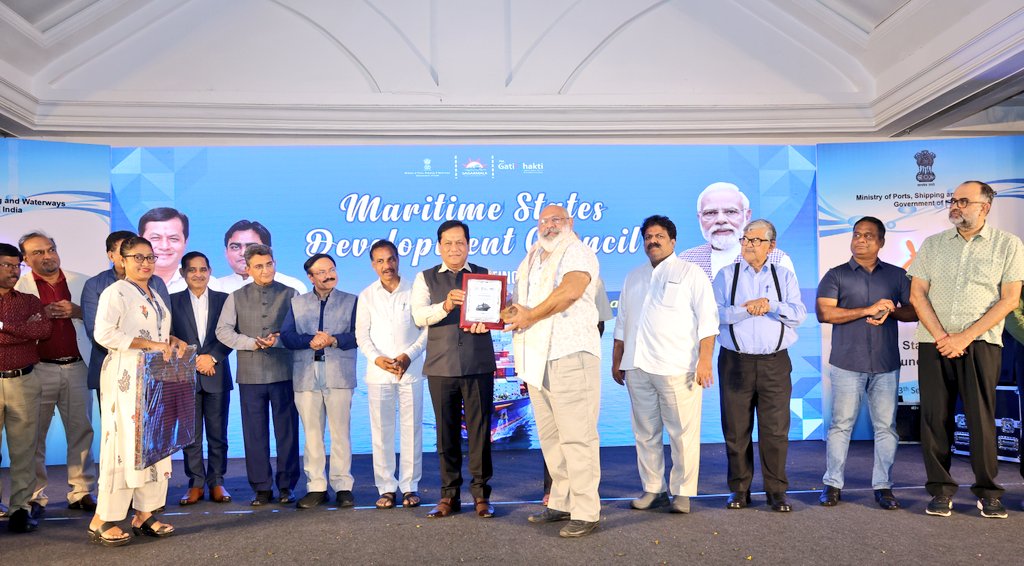
Maritime council approves plans for huge shipbuilding park spanning many states at Goa meet
GOA : The 20th Maritime State Development Council (MSDC) in Goa concluded on Friday with remarkable outcomes for India’s maritime sector, including plans for a huge shipbuilding park spanning multiple states. This ambitious initiative aims to consolidate shipbuilding capabilities across regions, fostering greater efficiency and innovation.
The two-day event also saw the resolution of more than 80 critical issues between the union government, states and Union Territories including port infrastructure modernisation, connectivity and security; statutory compliances; maritime tourism; navigation projects; and sustainability.
Several new and emerging challenges were also addressed, including the establishment of places of refuge for ships in distress, the development of radioactive detection equipment infrastructure to enhance security at ports, and recognising seafarers as essential workers and ensuring better working conditions and access to shore leave, a statement from ministry of ports, shipping and waterways said.
The implementation of a state ranking framework and a port ranking system was also discussed at the meeting, with the aim of fostering healthy competition and improving performance across India’s maritime sector.
The meeting was chaired by Shri Sarbananda Sonowal, Union Minister of Ports, Shipping and Waterways. Others in attendance included Shri Shantanu Thakur, Minister of State for Ports, Shipping and Waterways; Aleixo Sequeira, minister of captain of ports, Goa; Devendra Kumar Joshi, lieutenant governor, Andaman & Nicobar; Mankala S Vaidya, minister of fisheries, ports, and inland water transport, Karnataka; Thiru EV Velu, public works department minister, Tamil Nadu; and TK Ramachandran, secretary of the ports and shipping ministry.
At the meeting, Sonowal, emphasised the significance of MSDC’s contribution, saying, “MSDC has been instrumental in aligning policies and initiatives like the Indian Ports Bill and the Sagarmala program. MSDC’s efforts over the past two decades have facilitated the growth of over 50 non-major ports, which now handle more than 50% of India’s annual cargo. As major ports approach saturation, these non-major ports will play a crucial role in the future of India’s maritime sector.”
Growth story
He added that the Indian Maritime sector was growing like never before. The foundation stone of India’s 13th major port, worth ₹76,220 crores, was laid at Vadhavan in Maharashtra on 30 August, and the government has designated Galathea Bay in the Andaman & Nicobar Islands as another major port. This ₹44,000-crore project will be developed through a public-private partnership and aims to capture transshipped cargo currently handled outside India. The first phase is expected to be operational by 2029, Sonowal said.
The Sagarmala program, approved by the Union cabinet in 2015, envisions a total of 839 projects completion by 2035 with an estimated investment of ₹5.79 trillion. Of these, 262 projects have already been completed at a cost of about ₹1.40 trillion, and another 217 projects valued at around ₹1.65 trillion, are currently being implemented. These projects span several sectors and require coordination between union ministries, state governments, major ports and various other agencies.
To improve the ease of doing business in the maritime sector, the MSDC launched a National Safety in Ports Committee (NSPC) application on the National Single Window System. It aims to streamline regulatory processes, improve efficiency and reduce costs. The platform allows for real-time performance monitoring to enhance the operational efficiency of various departments through better information sharing.
Resolving maritime disputes
The launch of the Indian International Maritime Dispute Resolution Centre (IIMDRC) also marks a significant milestone. This platform will offer merit-based and industry-governed solutions to resolve maritime disputes efficiently, addressing the multi-modal, multi-contract, multi-jurisdictional, and multinational nature of maritime transactions. IIMDRC positions India as a global hub for arbitration, aligning with the ‘Resolve in India’ initiative.
Another noteworthy launch was that of the Indian Maritime Centre (IMC), a policy think tank designed to bring together maritime stakeholders who currently operate in silos. IMC is aimed at fostering innovation, knowledge sharing and strategic planning.
A highlight of the event was the keel-laying ceremony for India’s largest dredger, a 12,000 cubic metre trailer suction hopper dredger at Cochin Shipyard Limited, built in collaboration with IHC Holland.
Several maritime boards presented their innovations at MSDC. The Kerala Maritime Board showcased its techniques for monetising dredging efforts, while the Gujarat Maritime Board shared a case study on port-driven urban development initiatives. The Andhra Pradesh Maritime Board presented a maritime development masterplan, and the Indian Coast Guard shared a successful case study on the Maersk Frankfurt fire rescue operation.
Sonowal also spoke about the National Maritime Heritage Complex (NMHC) at Lothal, Gujarat, which he said would serve as an international tourist destination showcasing India’s rich maritime heritage. The NMHC will see international collaborations with 25 countries. MoUs have been signed with Portugal, the UAE, and Vietnam, and talks with France, Norway, Iran and Myanmar in advanced stages. Maharashtra and Gujarat have already developed their state pavilions for NMHC, and coastal states have been encouraged to participate and showcase their maritime heritage.
